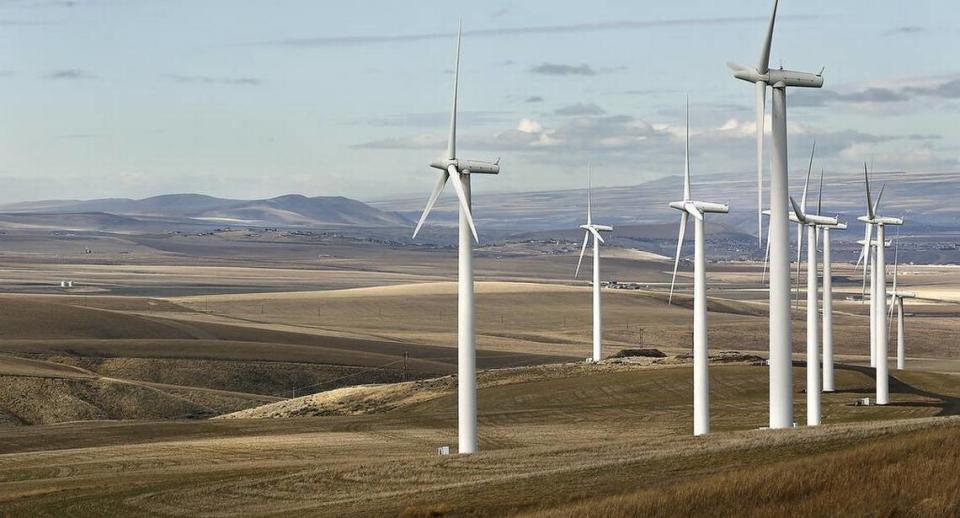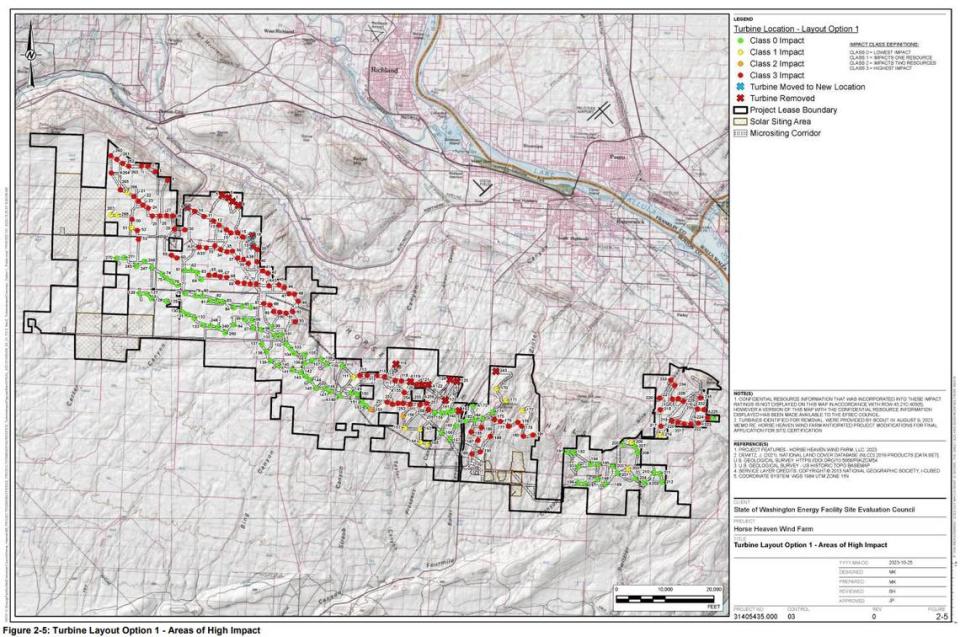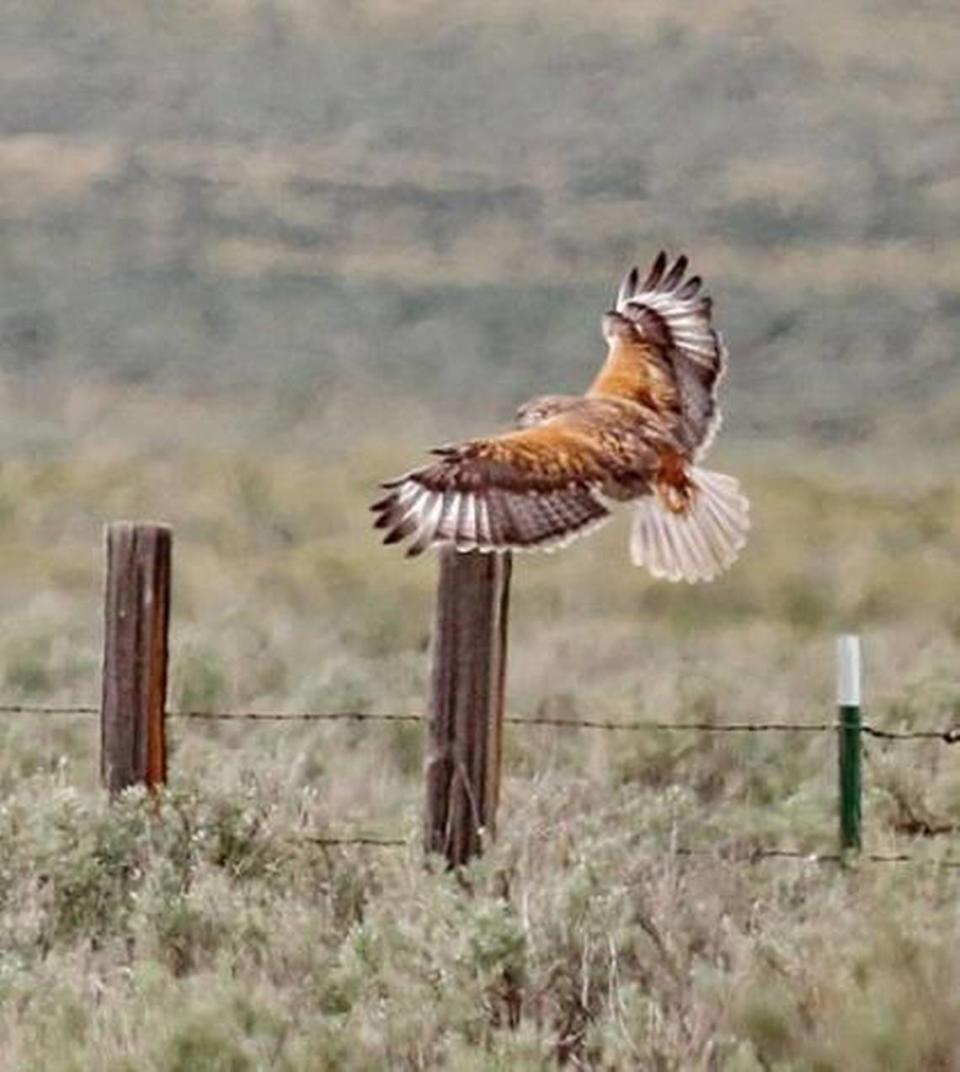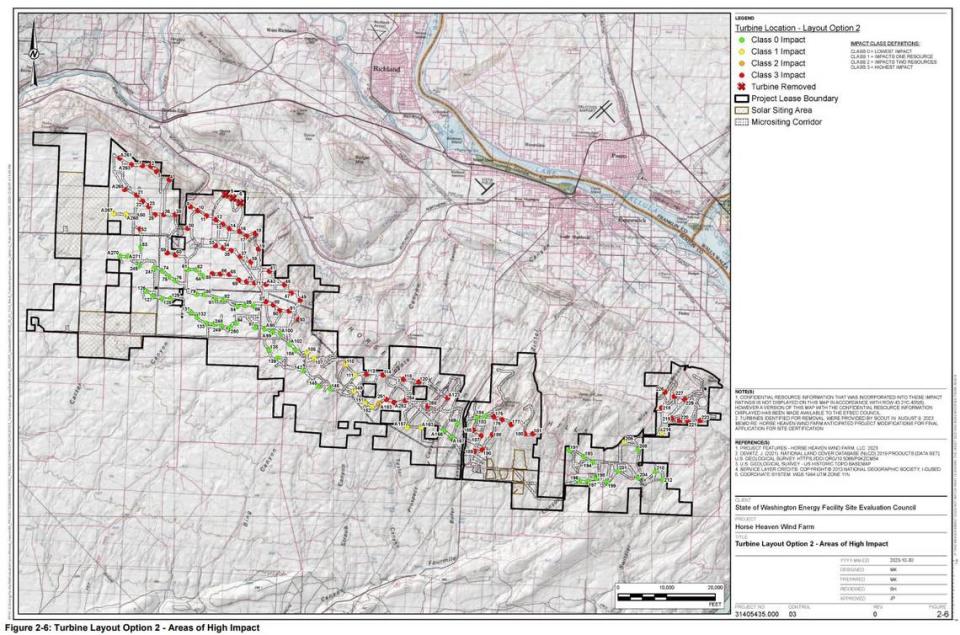Should wind turbines be limited on Tri-Cities Horse Heaven Hills? WA taking comments
- Oops!Something went wrong.Please try again later.
A key decision on whether the Tri-Cities area could become home to a large wind project that would dominate its southern views could be made this month after more public comment is received.
The Energy Facility Site Evaluation Council, or EFSEC, is expected to vote April 17 on a recommendation to significantly reduce the number of wind turbines that could be built at the proposed Horse Heaven Clean Energy Center.
The Energy Facility Site Evaluation Council, or EFSEC, will accept public comments online on the proposal through midnight Wednesday April 10. Go to comments.efsec.wa.gov.
Gov. Jay Inslee then will have 60 days to take one of three actions — approve the application with changes recommended by EFSEC, reject it or send the application back to the council for more work. Inslee also is expected to hear public comments before making a decision.
EFSEC is receiving pushback on the restrictions it has proposed that would reduce the number of turbines in the project — including in an op-ed in The Seattle Times last month by former U.S. Rep. Norm Dicks, D-Wash. He represented Washington state’s 6th Congressional District for 36 years.
Scout Clean Energy is proposing up to 222 wind turbines that would be 500 feet tall or an alternate plan with fewer, taller turbines. Then there would be up to 141 turbines with blades extending about 670 feet high, which is taller than the Seattle Space Needle.

The project as proposed would stretch over 24 miles along the Horse Heaven Hills from south of Finley and Kennewick to south of Benton City. It also could include solar arrays and battery storage.
EFSEC is charged with balancing the need for abundant clean energy sources to mitigate the effects of climate change while ensuring through reasonable methods that energy facilities will produce minimal adverse impacts on the environment.
It is expected to consider at its next meeting recommending that the number of turbines be cut by about half of more as it looks at those with the highest negative impact. That could mean removing about 116 of the proposed 222 of the 500 foot turbines or about 73 of the 141 taller turbines.
Scout has not said which of its two proposed turbine designs it plans to use.
The draft recommendation the council will consider would reduce the footprint to “reduce impacts to wildlife, visual resources and tribal cultural resources, including sacred places.” The proposed turbines impact on aerial firefighting and recreation also are considered.
Many of the turbines that would not be allowed under the proposal are the northern lines of turbines on the Horse Heaven Hills that would be most visible from the Tri-Cities.
Wind turbines and ferruginous hawks
EFSEC determined in an adjudicative order that loss of shrub-steppe habitat is already affecting ferruginous hawks in Washington state and that the clean energy project as proposed by Scout would pose a new and significant threat to the state endangered species.
Proposed restrictions on the project could increase the ability of the hawks to return to certain areas of historic usage, according to the EFSEC draft report for the governor.
More than 60% of the nesting territories of the ferruginous hawk in Washington state is concentrated in Franklin and Benton counties, which is considered the core breeding range in the state, according to the Washington state Department of Fish and Wildlife’s 2021 status review of the ferruginous hawk. It said that an average of 55 breeding pairs per year nested in the state between 1992 and 1995.

The council also found in the adjudicative order that pronghorn antelope also travel through and forage in the area of the proposed clean energy project. Proposed solar arrays would reduce and fragment their grazing habitat, but there is not adequate research to understand the impact of wind turbines on them, according to the draft report to the governor.
Dicks said in his Seattle Times op-ed that he was shocked by EFSEC’s proposed requirement for a two-mile buffer around hawk nests, some of the inactive for years, and a ban on activity year-round.
No state or federal regulation mandates such protection, he said.
The same claim has been made by Scout Energy, which said in a Jan. 19 letter to EFSEC that 84% of documented nests in and around the project area are no longer available for ferruginous hawk use.

Nests have been destroyed by wildfire or are located adjacent to residential or commercial development and “have zero likelihood of ever being used by the hawks again,” the letter said.
The two-mile buffer is not supported by science, it said, and the requirement could set a “dangerous precedent that will hobble Washington’ renewable energy future.”
Gerald Lewis, chairman of the Yakama Nation Tribal Council, responded to Scout’s letter with one of his own on March 14, reminding EFSEC that the two-mile buffer recommendation was developed by Washington state Department of Fish and Wildlife experts. The recommendation was developed using the best available science, he said.
It was a compromise on the part of biologists because ferruginous hawk’s averge care use areas are more than six miles, Lewis said in his letter to EFSEC.
Wind turbines and cultural resources
The proposed restrictions on turbines are not just for ferruginous hawks.
“The council is persuaded that the project, as proposed, presents compounding impacts to a number of resources of concern, including, but not limited to: the ferruginous hawk, wildlife movement corridors, shrub-steppe habitat, noise, visual aesthetics, shadow flicker, archaeological and architectural resources, traditional cultural properties and recreational opportunities,” says the draft report.
Eliminating turbines within two miles of active and historic nest sites for ferruginous hawks would not only minimize habitat disruption and risk of turbine strikes for hawks that use or return to those nesting areas, but would also decrease impacts to Yakama Nation cultural resources, scenic views, aerial firefighting, and paragliding and hang gliding, the report said.
Public comments and testimony convinced the council that the project as initially proposed with turbines along the Horse Heaven Hills ridgelines would an an undesirable ‘skylining’ effect on the views from Kennewick and Benton City.
“Tourists who come to Benton County to enjoy Eastern Washington’s wide-open spaces and unobstructed views would no longer be able to do so within sight of wind turbines or solar arrays,” the draft report said.
It also found the project would alter views now enjoyed by hikers and bikers in addition to tourists.

Evidence on cultural resources presented by Yakama Nation elders and the tribe’s archaeologist in an adjudicative hearing was kept confidential, but Lewis discussed it in his March 14 letter.
“Yakama nation has been very clear that the project is of great concern due to its proposed location within a highly sensitive cultural area, as well as the lasting impact it will have upon Yakima Nation’s treaty-reserved resources,” Lewis said.
“As proposed, the project is an industrial-scale development that is incompatible with — i.e. will irrevocably damage — multiple TCPs (Traditional Cultural Properties) that can never be mitigated or replaced,” he said.
The same care and consideration that was shown in the council’s discussion on ferruginous hawks should be given to the protection of cultural resources, he said.
Lewis asked that the council do more to protect cultural resources than is now proposed in the draft recommendation.
The council considered prohibiting all turbines, solar arrays and infrastructures east of Straub Canyon, which is south of Richland, to protect tribal cultural resources. The restriction failed to get a majority of council members in support and was not included in the draft recommendation.
The restrictions on the project’s wind turbines would not fully mitigate impacts to landscape and other natural features in and around the project site that the Yakama Nation has identified as having special cultural significance, the draft report said in its conclusion.
But reasonable measures have been proposed to minimize impacts and balance them with the benefits of encouraging development of clean energy, it said.
A vote on the draft report is likely at EFSEC’s April 17 meeting, staff said at the council’s March meeting.

